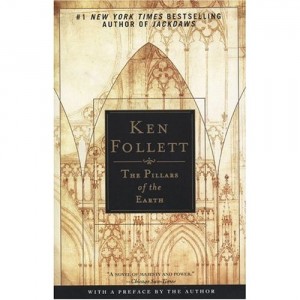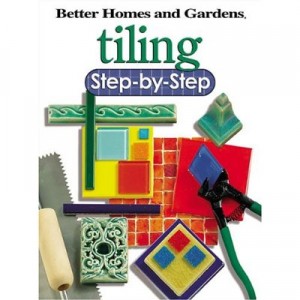I just finished this 40-hr long audio book (or nearly 1,000-page book); it took me more than 3 weeks of listening during my commute to/from work. The amazing thing is that I was kept mesmerized throughout the entire time. I am normally not sympathetic to long-winged story but this book is an exception. There are plenty of bad guys to hate (Bull-dog William Helmley, scheming Bishop Wallivan, little-minded Alfred and other monks) and good guys to cheer for (Prior Philip, Alliena, Tom Builder, Jack Jackson, Ellen and etc.)
I utterly enjoyed the subtlety of mason cathedral building. How the original cathedral built by Alfred fell to ground and how Jack managed to re-build it and added so many of the newer/fancier elements he learned from France. I came to appreciate it even more because I was reading the “tiling” book at the same time. The intricacy of ensuring the seemingly strong masonry building from collapsing has a lot to do with the support and allowance for flexing under the strong wind and high temperature excursion. This is the ying and yang of the stone building. If you can balance the ying and yang, the building can last for centuries. If not, it’ll crumble very shortly. The irony of the story is that Jack was the one that burned down the original building and he was also the one who rebuilt it.
The chaos of the time in England were revealed. It’s almost like reading Chinese Three-kingdom (San-guo) Affair. People had to put up with the constant war and the shifting of power. And yet people’s lives go on. The archaic taxing system of the time was to force people to pay rent for the farms and license for the market place. The added restriction that people must use a certain wheat grinder seems very inefficient and yet it’s no different than a tax/tariff.
The complicated and evolving relationship between the monarchy (King Henry and his son) and the Catholic church also played out in the book. Keeping the politics from religion was quite difficult due to the symbiosis as the monarch needs legitimacy from the Church and the church needs protection from the Governing Power. The fact that Kingsbridge needed a wall and Knight Richard’s (Aliena’s brother) protection just to keep Earl William Helmley out is a classic example that a prospering economy needs the protection of the government body. Without it, the economy would collapse due to lack of confidence and the uncertainty.
Another good thing about this novel is that the characters are quite believable and deeply rooted in the reality of the time and yet grounded in basic human emotions – love, hate, hope and fear. I don’t read novels often but I see why novels are appealing to people because the author can make up the emotions and thoughts of the people as the story evolves. In real life, we don’t usually have the advantage in knowing what people are thinking and how they’re feeling at the time. This is especially evident in the love scenes throughout the story. The author thrives at exploring the steamy love scenes making the reading grasping for air. He’s also very good at describing the violent war and rape scenes that make you feel the blood splashed on your face.
A quick comment on the key characters: (You may not want to reach the following if you haven’t read the book yet so I don’t ruin the ending for you)
– Prior Philip: The quintessential high-integrity monk with a relentless pursuit to do good and build a cathedral for the church. When it comes to religion, he played by the book, forcing Tom Builder/Ellen AND Jack/Aliena apart to legitimize their marriage. But when it comes to worldly thing, he’s very smart in getting things done, keeping Bishop Wallivan at bay. He’s exactly the kind of religious leader you want.
– Tom Builder: the central character of the 1st part of the story. Tom went from extreme poverty to being the master builder building the cathedral. He’s the leader of the mason craft persons. He had a grand vision for the church and yet could not complete it before his death. He’s a protector and leader with high-level of integrity. He reminds me of a good engineering lead/manager.
– Ellen: the ultimate liberal. Tom’s mistress/and wife after the death of his wife. A strong-will woman, she brought up Jack on her own in the forest. She reminded me the newly-liberated women in the 60’s.
– Aliena: Born a sheltered daughter of an earl, she was raped by William Hamleigh when her father lost his Earlship to Piercy Hamleigh (William’s father). She became a strong street-smart business woman and could kill to defend her brother Richard. She married Alfred after her wool business was burned down by William so she could continue to support Richard’s knighthood – a promise she made to her father. But her heart was with Jack. She gave birth to Tommy and later went on a search for Jack all the way to Spain and found her. The church rules forced her to live apart from Jack for 10 years and finally married Jack after Richard killed Alfred. Her son, Tommy, later became the Earl of Shailing. The irony is that Aliena is a much better governor/lord of Shiring than her brother. Tommy inherited her genes.
– Jack, the central character for the last half of the story. He was a little boy when he met and became fascinated with Aliena, a girl 5 years to his senior. Living in the forest with his mother and then living with Tom’s family (conflicts with Alfred) and then became an intern monk working for Philip in the church, he’s like the little smart kid that weathers all harsh environments. His artistry for Cathedral took on a fast ramp when he traveled through the rest of Europe to Spain and France. With his quick wit, he brought back the weeping Virgin Mary back and the seed money needed to rebuild the church. Tom’s love and passion for Alliena never diminished throughout the trials and tribulations. To me, Jack is more like an architect and a super civil engineer with the street-smartness to get his way.
– William Hamleigh, the ultimate bully in the story: His crimes were so numerous that the author kept him around to the end to keep the readers guessing how he’s going to die. He was hung. The author portrayed him to be an abused boy by his mother and he was very fearful of the death and his likely final resting place – hell. His redeeming value is that he’s fearful of God and he’s not as scheming as Bishop Waleran.
– Bishop Waleran: the ultimate evil at the high place of Catholic church. He would manipulate William Helmley to get his way. His final straw was when he accused Philip to commit fornication and give birth to Jonathan, Tom Builder’s son. He lost all his credibility when the accusation did not pan out for him and his conspiracy to kill Archbishop Thomas backfired on him. He ended up being a lowly monk, repenting his sins for the rest of his life.
For more characters, read this Wiki page.
Overall, this is one of the best novels I have read for many years. The story was captivating and interesting. The bad guys and good guys all got what they deserved at the end. I’ve learned a few things along the way. Can’t do better than that.


